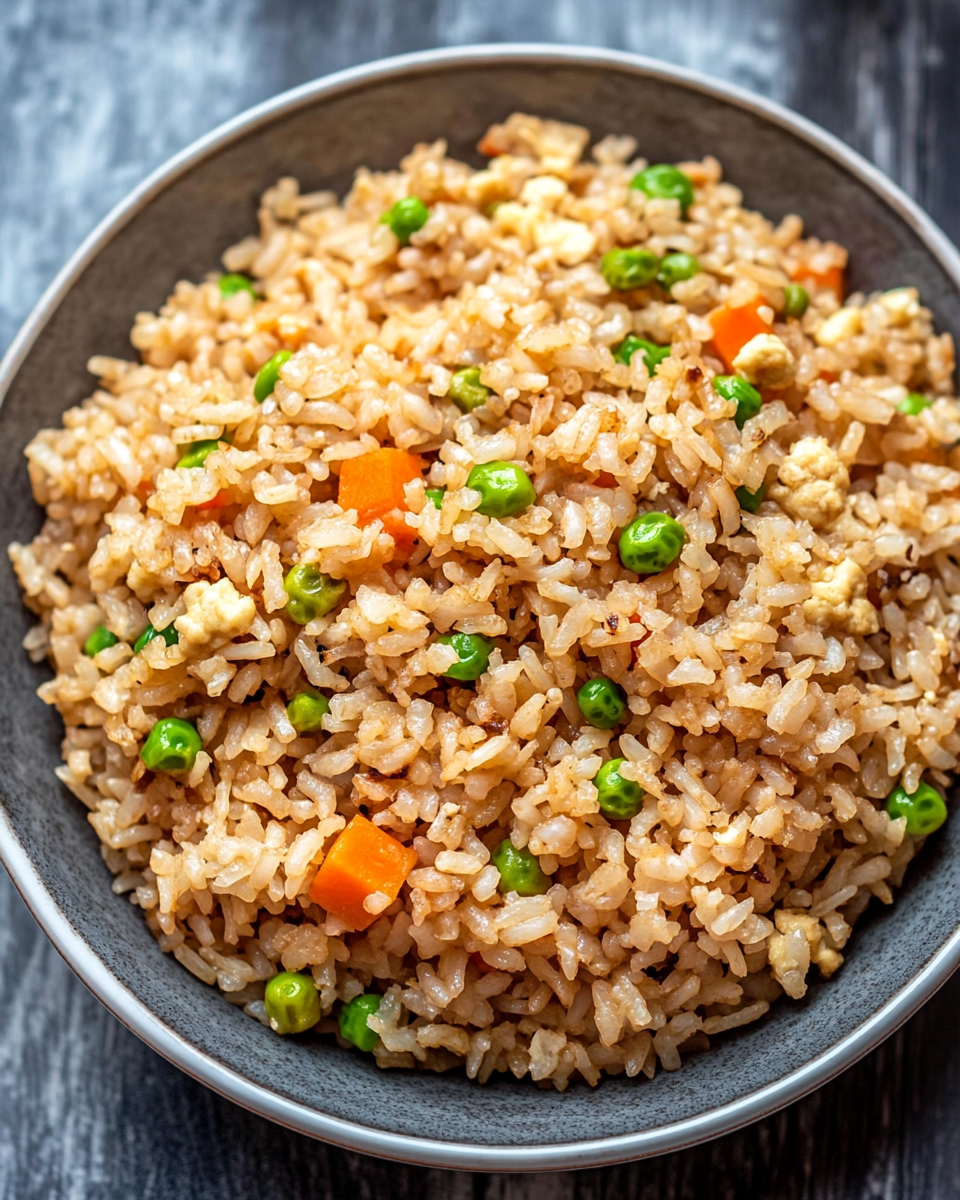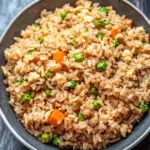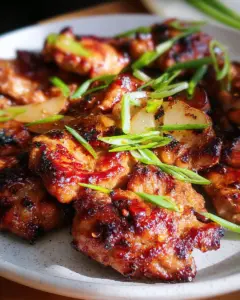Few dishes are as versatile and universally satisfying as fried rice. This humble yet flavorful dish transforms leftover rice into a savory masterpiece, combining tender vegetables, fluffy scrambled eggs, and a rich buttery soy sauce. Inspired by hibachi-style cooking, this recipe delivers restaurant-quality results with minimal effort. The key lies in using cold, day-old rice, which fries up light and separate, unlike freshly cooked rice that turns sticky. Whether you need a quick weeknight dinner or a crowd-pleasing side, this easy fried rice adapts to your tastes while staying true to its irresistible texture and depth of flavor.

Essential Tools and Equipment
To achieve the best results, having the right tools makes all the difference:
- Wok or large skillet: A carbon steel wok distributes heat evenly, but a large non-stick skillet works well too.
- Wooden spatula: Prevents rice from sticking and makes tossing ingredients easier.
- Mixing bowls: For prepping vegetables, eggs, and sauce separately.
- Measuring spoons/cups: Ensures precise seasoning for balanced flavor.
Why These Tools Matter
- A wok’s high sides allow for better stir-frying without spilling.
- A non-stick skillet is a good alternative if a wok isn’t available.
- Cold, dry rice is non-negotiable—freshly cooked rice will clump and turn mushy.
Preparation Tips for Success
- Rice prep: Cook rice at least 4 hours ahead (overnight is ideal) and refrigerate uncovered to dry it out.
- Uniform cuts: Chop all vegetables into similar-sized pieces for even cooking.
- Mise en place: Have all ingredients prepped and within reach—fried rice cooks quickly.
Ingredients for Classic Fried Rice
For the Fried Rice:
- 4 cups cooked short-grain white rice (long-grain or jasmine rice also work)
- 1 egg, whisked (adds protein and texture)
- ½ cup chopped carrots (fresh or frozen for convenience)
- ½ cup peas (frozen peas retain brightness)
- ½ cup diced white onion (for sweetness and crunch)
- 2–3 tablespoons peanut or vegetable oil (high smoke point for frying)
- 2 teaspoons sesame oil (adds nutty aroma; optional but recommended)
For the Butter-Soy Sauce Mixture:
- 4 tablespoons unsalted butter, softened (creates a rich, velvety coating)
- 2 tablespoons low-sodium soy sauce (adjust to taste)
Step-by-Step Cooking Instructions
1. Prepare the Rice
- Cook rice according to package instructions. Spread it on a tray, let it cool, then refrigerate uncovered for at least 1 hour (overnight is best).
2. Make the Butter-Soy Sauce
- Soften butter (microwave in 5-second bursts if needed). Mix with soy sauce—it won’t fully emulsify, which is fine.
3. Scramble the Egg
- Heat 1 teaspoon oil in a wok/skillet over medium heat. Pour in whisked egg, let it set slightly, then scramble into small curds. Remove and set aside.
4. Sauté the Vegetables
- Add another teaspoon of oil. Stir-fry carrots, peas, and onion for 3–4 minutes until tender but crisp. Season with a pinch of salt. Transfer to a plate.
5. Fry the Rice
- Increase heat to medium-high. Add remaining oil, then cold rice. Break up clumps with a spatula. Stir every 30 seconds for 4–5 minutes until grains are lightly toasted.
6. Season and Combine
- Drizzle butter-soy mixture over rice, tossing to coat evenly. Fold in cooked veggies and egg. Finish with sesame oil for depth. Taste and add more soy sauce if needed.
Pro Tips for Customization
- Protein boost: Add diced chicken, shrimp, or tofu in step 4.
- Extra crunch: Toss in bell peppers or water chestnuts.
- Spice it up: Stir in sriracha or chili garlic sauce with the butter-soy mix.
A well-made plate of fried rice deserves presentation that matches its flavor. For a restaurant-worthy finish, garnish with thinly sliced green onions or a sprinkle of toasted sesame seeds. A drizzle of sriracha mayo or a side of yum yum sauce adds creamy heat, while pickled ginger offers a bright contrast. Serve in a warm bowl to maintain temperature—fried rice is best enjoyed immediately.
For family-style meals, pair with small dishes of soy sauce and chili oil for personalized seasoning. If serving as part of a larger spread, keep portions modest (about ½ cup per person as a side) to leave room for complementary dishes.
Common Mistakes and How to Avoid Them
Even experienced cooks encounter pitfalls with fried rice. Here’s how to troubleshoot:
- Soggy or sticky rice: The cardinal sin of fried rice. Always use cold, day-old rice—freshly cooked rice releases excess starch. If your rice is still moist, spread it on a baking sheet and let it air-dry for 15 minutes before frying.
- Overcrowding the pan: Frying in small batches ensures each grain gets crispy. A 12-inch skillet is the minimum size for 4 cups of rice.
- Underseasoning: Soy sauce alone isn’t enough. Amplify flavor by adding a pinch of white pepper or MSG (¼ teaspoon) to the butter-soy mixture. Taste as you go.
- Low heat: Fried rice requires medium-high to high heat to achieve the signature “wok hei” (breath of the wok). If your stove runs cool, preheat the skillet for 2 full minutes before adding oil.
Pro Fixes:
- If rice sticks, deglaze with 1 tablespoon of shaoxing wine or water, scraping the pan.
- For bland results, finish with a splash of fish sauce or oyster sauce (½ teaspoon at a time).
8 Ideal Side Dishes to Complete the Meal
Fried rice shines as part of a balanced spread. These pairings cater to diverse tastes:
- Egg Drop Soup: A light, silky counterpoint to the rice’s richness.
- Japanese Cucumber Salad (Sunomono): Vinegary crunch cuts through the dish’s umami.
- Teriyaki-Glazed Salmon: Adds protein and a caramelized contrast.
- Steamed Edamame with Sea Salt: A simple, protein-rich appetizer.
- Stir-Fried Garlic Bok Choy: Earthy greens balance the meal.
- Crispy Spring Rolls: Textural contrast with a dipping sauce.
- Miso-Grilled Eggplant: Savory depth for vegetarian menus.
- Spicy Tuna Tartare: Luxurious pairing for seafood lovers.
Budget Tip: Frozen dumplings or store-bought gyoza make an effortless addition.
Techniques to Elevate Your Fried Rice
- Layering flavors: Sauté minced garlic and ginger in the oil before adding rice for an aromatic base.
- Textural contrast: Top with crunchy fried shallots or roasted peanuts before serving.
- Color pop: Use red bell peppers or purple cabbage for visual appeal.
For Meal Preppers:
Double the recipe and store portions in airtight containers. Reheat in a skillet with a teaspoon of oil to revive crispness.
Take your fried rice from good to extraordinary with these professional techniques:
- The Day-Old Rice Rule
For optimal texture, spread freshly cooked rice on a baking sheet and refrigerate uncovered for at least 4 hours. This drying process mimics restaurant-quality results better than simply storing rice in a container. - Fat Selection Matters
While vegetable oil works, combining it with rendered chicken fat (schmaltz) or duck fat adds incredible depth. Use 1 tablespoon along with your regular oil. - The Egg Technique
For ribbon-like egg strands, push rice to one side of the wok, pour beaten egg into the empty space, and let it set slightly before scrambling and mixing. - Acid Balance
A squeeze of lime juice or rice vinegar (½ teaspoon) at the end brightens flavors without making the dish sour.
Proper Storage and Reheating Methods
Refrigeration Guidelines
Store leftover fried rice in an airtight container for up to:
- 3 days in the refrigerator
- 1 month in the freezer (portion into individual servings)
Freezing Tips
- Cool completely before freezing
- Press plastic wrap directly onto the rice surface to prevent freezer burn
- Label with date and contents
Reheating for Best Quality
Stovetop Method (Recommended):
- Heat 1 teaspoon oil in a skillet over medium heat
- Add rice and break up clumps
- Sprinkle 1 tablespoon water and cover for 1 minute
- Uncover and stir-fry until hot (3-4 minutes total)
Microwave Alternative:
- Place rice in a microwave-safe bowl
- Cover with a damp paper towel
- Heat in 30-second intervals, fluffing between each
Food Safety Note
Never leave fried rice at room temperature for more than 2 hours. The combination of rice and eggs creates ideal conditions for bacterial growth when improperly stored.
Comprehensive FAQs (Answering “People Also Ask”)
Can I use brown rice instead of white?
Yes, but adjust expectations. Brown rice’s bran layer makes it inherently chewier. For best results:
- Use short-grain brown rice
- Increase cooking time by 1-2 minutes when frying
- Add an extra tablespoon of liquid (water or broth)
Why does restaurant fried rice taste different?
Commercial kitchens use three key advantages:
- Extremely high BTU burners (15,000+ vs home stoves’ 7,000-10,000)
- Seasoned carbon steel woks that retain heat
- MSG (monosodium glutamate) in their seasoning
How can I make fried rice without soy sauce?
Try these alternatives:
- Coconut aminos (for paleo/soy-free)
- Fish sauce (use half the amount)
- Mushroom seasoning (Asian markets carry this)
What’s the best protein to add?
Popular options ranked by cooking time:
- Shrimp (add last, cooks in 2 minutes)
- Char siu pork (pre-cooked, just needs heating)
- Chicken (dice small, cook before vegetables)
Can I make fried rice in an air fryer?
Surprisingly yes, with caveats:
- Works best with 2 cups or less
- Toss with 1 teaspoon oil first
- Cook at 375°F for 6-8 minutes, shaking halfway
- Add pre-cooked proteins/veggies after
Final Thoughts and Encouragement
Mastering fried rice represents one of cooking’s most valuable skills – the ability to transform humble ingredients into something greater than the sum of its parts. Each attempt builds intuition about heat control, seasoning balance, and ingredient timing. Remember that even imperfect batches still taste delicious, and every cook develops their own signature version over time.
For those looking to continue their culinary journey, consider exploring regional variations like:
- Yangzhou fried rice (with barbecue pork and shrimp)
- Thai pineapple fried rice (served in a fruit shell)
- Korean kimchi bokkeumbap (fermented spice kick)
Fried Rice
Ingredients
For the Fried Rice:
- 4 cups cooked short-grain white rice long-grain or jasmine rice also works
- 1 egg whisked and scrambled
- 1/2 cup chopped carrots fresh or frozen
- 1/2 cup peas frozen recommended
- 1/2 cup white onion chopped
- 2 –3 tablespoons peanut canola, or vegetable oil
- 2 teaspoons sesame oil optional
For the Butter-Soy Sauce Mixture:
- 4 tablespoons unsalted butter softened
- 2 tablespoons low-sodium soy sauce
Instructions
- Prepare the rice: Cook the rice according to the package instructions. Chill it in the refrigerator for at least 1 hour (preferably overnight) so it’s cold and firm for frying.
- Make the butter-soy sauce mixture: Soften the butter by leaving it at room temperature or microwaving in short intervals. Mash with a fork, then mix in the soy sauce. It’s okay if it doesn’t combine completely.
- Cook the egg: Heat a splash of oil in a large skillet or wok over medium heat. Add the whisked egg and scramble it, breaking it into small chunks. Remove from the skillet and set aside.
- Cook the veggies: Add another splash of oil to the skillet. Sauté the carrots, peas, and onion for about 4 minutes, or until tender. Season with a pinch of salt and pepper. Remove from the skillet and set aside.
- Fry the rice: Add another splash of oil to the skillet, then add the cold, cooked rice. Toss every 30 seconds, cooking for 4-5 minutes until warmed through and lightly browned. Adjust heat as needed to prevent burning.
- Season the rice: Drizzle the butter-soy sauce mixture over the rice, tossing to coat evenly. Cook until there are no more visible white grains.
- Combine everything: Return the veggies and scrambled egg to the skillet. Drizzle with sesame oil, if using, and stir until well combined. Taste and adjust seasoning with more soy sauce if needed. Serve immediately.
- Notes
- Cold rice: Always use cold rice for fried rice. Freshly cooked rice is too moist and will clump together.
- Veggies: Frozen peas and carrots are a convenient option and minimize prep time. Fresh vegetables can also be used.
- Soy sauce: Start with low-sodium soy sauce to prevent the dish from becoming too salty. Add more to taste if needed.
- Wok recommendation: A wok is ideal for this recipe due to its even heat distribution. If using a skillet, choose the largest one you have and use plenty of oil to prevent sticking.
- Keep ingredients moving: Continuously stir the rice and veggies in the skillet to prevent burning or sticking. Prepping ingredients in advance makes the cooking process easier.






